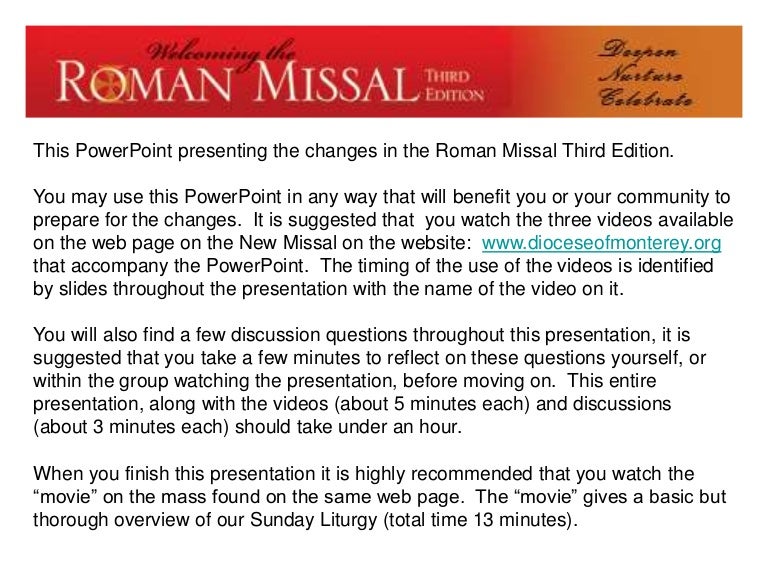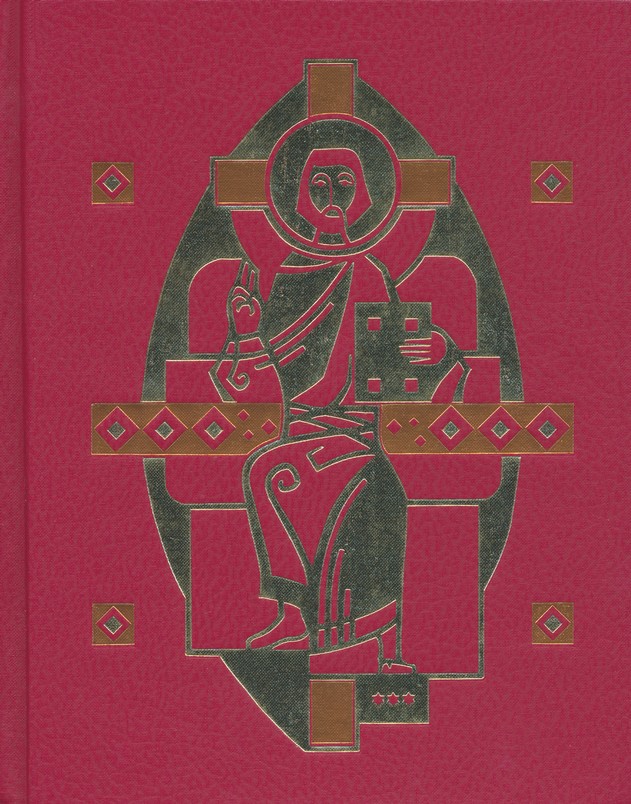The Roman Missal, 3rd Chapel Edition 4.8 out of 5 stars 92. Only 9 left in stock (more on the way). Pastoral Care of the Sick. Overall, however, the transition to the new Spanish Missal is nowhere near as drastic a change as was the transition to the 3rd edition of the English Missal. There are very few changes to the Ordinary of the Mass, and very very little that affects the words spoken by the faithful. The Spanish translation of the third edition of the Roman Missal for use in the United States. The revised text has been published and, as of this Advent 2018, this is the only approved text for use in the Celebration of Mass in Spanish in the United States of America. The Roman Rite has evolved over the centuries in very diverse contexts and situations, and it has endured to our own day precisely because of its capacity to adapt and be shaped by the distinct cultures where it has been celebrated. Holy Week in the Third Edition of The Roman Missal.
Latest edition of Roman Missal’s Spanish translation may speed up approval of U.S. version
By Father Randy Stice
In recent columns I have discussed the new Order of Matrimony and the new translation of the Order of Confirmation. In this column I want to introduce the Misal Romano, Tercera Edición, the Spanish translation of the Roman Missal, Third Edition. The English translation was introduced four years ago on the First Sunday of Advent 2011. The text for the Misal Romano, Tercera Edición has been submitted to the Holy See for approval (recognitio).
The basis for the U.S. Spanish Missal is the Misal Romano, Tercera Edición produced by the Mexican bishops and approved by the Apostolic See. It is hoped that this will expedite the approval of the U.S. missal. The U.S. edition will differ from the Mexican edition in four ways. First, the proper calendar for the United States will replace the Mexican calendar. Second, the U.S. edition will have 21 Latin American patronal feasts to reflect the presence of many different immigrant populations among the Spanish-speaking faithful in the United States. A third addition is a Spanish translation of the “Norms for the Distribution and Reception of Holy Communion under Both Kinds in the Dioceses of the United States of America.” Fourth, the U.S. edition will include the U.S. adaptations for the General Instruction of the Roman Missal (GIRM).
The Apostolic See asks each Conference of Bishops to formulate adaptations for their dioceses, subject to the approval of Rome. One of the guiding principles for adaptations is stated in the section on the gesture for venerating the altar, which in the United States is done by kiss. The General Instruction states: “where a sign of this kind is not in harmony with the traditions or the culture of some region, it is for the Conference of Bishops to establish some other sign in its place, with the consent of the Apostolic See” (GIRM, 273).
Let me give a couple of examples of adaptations granted to U.S. dioceses. In general, “the table of a fixed altar should be of stone and indeed of natural stone” (GIRM, 301). However, in the United States “wood which is dignified, solid and well-crafted may be used, provided that the altar is structurally immobile” (GIRM, 301). Another example is the color of sacred vestments. “Besides the color violet, the colors white or black may be used at funeral services and at other Offices and Masses for the Dead in the Dioceses of the United States” (GIRM, n. 346e). Adaptations in the GIRM are indicated by the phrase, “in the Dioceses of the United States.” The subject of adaptations is addressed in GIRM, 390.

The Misal Romano, Tercera Edición will follow the layout and content of the English-language Roman Missal, Third Edition. Unlike other Spanish-language editions, the U.S. edition will include music for all the dialogues between the priest and people and each Preface. The text with music will appear alongside the text, and an appendix will contain additional musical settings. The chant settings will follow the intonations found in the English-language Roman Missal.
The Misal Romano, Tercera Edición will have short pastoral biographies of American saints and blessed as well as an appendix with biographies of patronal feasts. It will have the same number of illustrations as the English-language Roman Missal, and the artwork will reflect the Hispanic culture. In order to encourage Marian devotion, it will include several Mass formularies and Prefaces in the Common of the Blessed Virgin Mary.
The American bishops plan to produce a series of catechetical videos in Spanish to introduce the new missal. Topics include a history of the Mass from the Council of Trent to today, an explanation of the process of translation, and instruction on the structure and historical background of the Mass. There also will be catechesis on notable changes, such as the change in the formula of consecration of the wine from “for all (por todos los hombres)” to “for many (por muchos).”
The goal is a translation and ritual book that “will serve as a unifying text for Spanish-speaking Catholics in the United States” and reflect the diversity of our Spanish-speaking population. ■
Father Stice is pastor of St. Mary Church in Athens and directs the diocesan Office of Worship and Liturgy. He can be reached at frrandy@dioknox.org.
EGINNING later this year, a new Spanish translation of the Latin, 3rd typical edition of the Missale Romanum goes into force in the United States of America. This new missal—the Misal Romano, tercera edición—will become available from publishers beginning in May 2018. Its use will be optional beginning at the Vigil of Pentecost (19 May 2018) and mandatory by the First Sunday of Advent (2 December 2018).


When the English translation of the 3rd typical edition was released in 2011, one of the chief improvements was the increased presence of musical notation in the pages of the missal. At the time, a massive project was undertaken to introduce these simple, but beautiful chants to clergy and laity throughout the Anglophone world. The same opportunity now presents itself with respect to Spanish-speaking communities in the United States. This is a significant moment for Spanish-speaking Catholics to reintroduce truly sacred music to their celebrations, in place of the American-Hispanic music that has for so long been imposed upon their communities.
In order to help the faithful become familiar with the 2011 English missal chants, the International Commission on English in the Liturgy (ICEL) authorized the free and wide dissemination of the new settings. They even produced a very helpful website to assist liturgical musicians in English-speaking dioceses and parishes.
Now, the same permission has been granted for the distribution of the new Spanish missal chants. A lovely and user-friendly website has been published by the Zipoli Institute. The goal of the institute (which is an apostolate of the Institute of the Incarnate Word) is to provide resources that help to make sacred music accessible in mission territories.
Included in the Spanish section of the Zipoli Institute’s website are three resources of particular importance:
1. Practice recordings of the Misal Romano chants (in both standard and low pitches)
2. A printable booklet of the Misal Romano chants for congregational use (in both single-sheet and double-sheet formats)

3. A collection of quality, Spanish hymns for various occasions
The Zipoli Institute is also a treasure trove of materials for the sung Mass in English and for Mass in the Extraordinary Form. Additional materials are provided or referenced for sacristans, for funeral/wedding planning, and for singing polyphony.
I highly recommend a visit to their website to explore the abundance of resources they provide.
Roman Missal Third Edition In Spanish Translation
Next week, a special conference will be held just outside Washington, DC to provide training in the new chants of the Misal Romano. On Friday, 27 April 2018 the workshop will be tailored to clergy and seminarians, whereas the sessions on Saturday, 28 April 2018 are directed toward music directors, choirs, and congregations.
Let us pray that the introduction of this new translation of the Misal Romano will enable Spanish-speaking Catholics to sing a truly new song to the Lord!